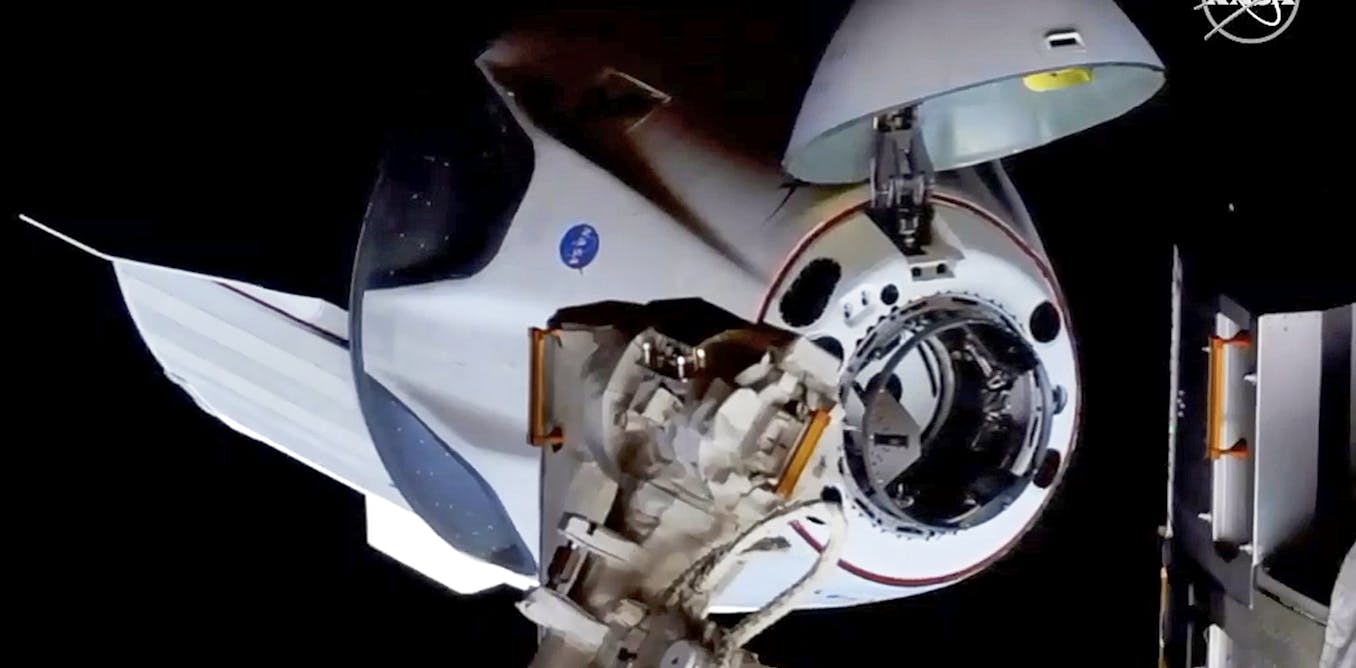
The Crew Dragon spacecraft, produced by the private company SpaceX, is slated to return from the International Space Station (ISS) and splash around in the Atlantic Ocean on August 2. Depending on a favorable weather forecast and a successful final week on the ISS, NASA Astronauts Robert Behnken and Douglas Hurley will begin the decoupling procedure on August 1 and re-enter Earth’s atmosphere the next day, a total of 64 days from takeoff.
The historic launch took place on May 30 from NASA’s Kennedy Space Center in Florida, marking the first time that a commercial space company has brought humans into orbit around Earth. But while the launch was an unforgettable experience, the reentry will be even more risky, presenting a tense moment for mission control. SpaceX founder Elon Musk said the reentry is indeed his “biggest concern.”
SpaceX and NASA’s joint mission was successful in docking with the ISS, so that astronauts could complete scientific and maintenance work, including four spacewalks.

NASAhandout / EPA
Importantly, the primary objective of the mission is to test and demonstrate the vehicle’s ability to safely transport the crew to and from Earth’s orbit, as the first step in the plan to begin regular ISS missions and flights. commercial space.
Re-enter danger points
The extreme speeds and temperatures that the vehicle must withstand present a great challenge for engineers and make reentry the most dangerous part of a mission.
The danger begins with finding the correct angle of the trajectory when the spacecraft enters the upper atmosphere. If it’s too steep, astronauts will experience potentially fatal g-forces, and the friction of air drag could cause the spacecraft to explode. If it is too shallow, the capsule will catastrophically jump out of the atmosphere and return to Earth orbit.
The spacecraft will enter the atmosphere above 27,000 km / hour. That is 7.5 km / second, or more than 20 times the speed of sound. On the units you prefer, this is fast. At these speeds, a very strong shock wave forms around the front of the vehicle, compressing and overheating the air. Managing the immense heat load is a major reentry engineering challenge.
At the most extreme stage, the air temperature in the shock layer exceeds 7,000 ° C. In comparison, the temperature at the Sun’s surface is around 5,500 ° C. This makes the vehicle’s heat shield so hot. it begins to glow, a process called incandescence. SpaceX’s new advanced PICA-X material heat shield has managed to protect the capsule on test flights, and then recovered in a highly charred state.
The air molecules around the vehicle also break down into positively charged atoms and free electrons, a so-called plasma. When some of the molecules recombine, excess energy is released as photons (light particles), giving the air around the vehicle an amber glow.
This plasma layer can be beautiful, but it can cause radio blackouts. When an electron travels along a conducting wire, we have electricity. Similarly, when free electrons move through the plasma around the vehicle, we have an electric field. If the electric field becomes too strong, it can reflect and attenuate the radio waves trying to reach the spacecraft.
The outage not only leads to a loss of connection to the on-board crew and flight data, it can also make remote control and orientation impossible. The Apollo missions, the Mars Pathfinder and the recent and unsuccessful launch of the 2018 Soyuz rocket suffered a communications blackout in the order of minutes. NASA mission control is anticipating a nervous six-minute blackout during the peak warm-up phase of the Crew Dragon’s return – if anything goes wrong during this time, it’s in the hands of the astronauts.
Another risky stage is parachute assisted landing. The Crew Dragon will deploy four parachutes in the final stage of reentry, as the vehicle descends into a gentle splash in the Atlantic Ocean off the Florida coast. SpaceX has tested this maneuver 27 times before next week’s manned landing, so it should work.
Future goals
A successful landing will have huge implications: reducing the cost of space exploration by using reusable rockets and allowing private space exploration. While SpaceX designed the Crew Dragon vehicle under contract with NASA, the company is free to use the spacecraft for commercial flights without NASA’s involvement after operational certification.
SpaceX has a partnership with the commercial aerospace company Axiom Space, which has the ultimate goal of building the world’s first commercial space station. The proposed business activities for the station are extensive: from research and manufacturing in space to supporting space exploration.
Then there is space tourism. Private citizens are already queuing up for their ticket to space, and with a successful Crew Dragon crash, they won’t wait long. US space tourism company Space Adventures (in association with SpaceX) plans to offer zero-gravity atmospheric flights, orbital flights with a spacewalk option, and Moon turns in late 2021.
Read more: Elon Musk’s spaceship may be more of a moral catastrophe than a bold step in space exploration
It is debatable whether the costs, environmental impact and dangers of space flight are justified for space tourism. As shown in this article, the security information required for Space Adventure ticket holders will be much more comprehensive than your usual “take a moment to read the security card in the seat pocket in front of you.”